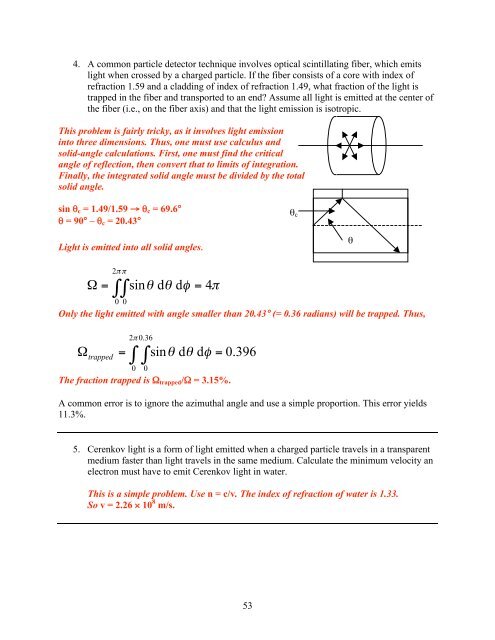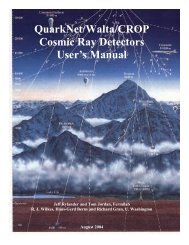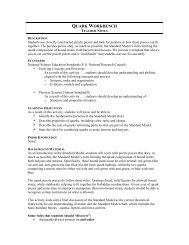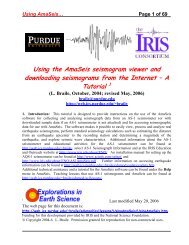Teaching Modern Physics - QuarkNet - Fermilab
Teaching Modern Physics - QuarkNet - Fermilab
Teaching Modern Physics - QuarkNet - Fermilab
Create successful ePaper yourself
Turn your PDF publications into a flip-book with our unique Google optimized e-Paper software.
4. A common particle detector technique involves optical scintillating fiber, which emits<br />
light when crossed by a charged particle. If the fiber consists of a core with index of<br />
refraction 1.59 and a cladding of index of refraction 1.49, what fraction of the light is<br />
trapped in the fiber and transported to an end? Assume all light is emitted at the center of<br />
the fiber (i.e., on the fiber axis) and that the light emission is isotropic.<br />
This problem is fairly tricky, as it involves light emission<br />
into three dimensions. Thus, one must use calculus and<br />
solid-angle calculations. First, one must find the critical<br />
angle of reflection, then convert that to limits of integration.<br />
Finally, the integrated solid angle must be divided by the total<br />
solid angle.<br />
sin θc = 1.49/1.59 → θc = 69.6°<br />
θ = 90° – θc = 20.43°<br />
Light is emitted into all solid angles.<br />
2π<br />
π<br />
Ω = ∫∫ sinθ<br />
dθ<br />
dφ<br />
= 4π<br />
0 0<br />
Only the light emitted with angle smaller than 20.43° (= 0.36 radians) will be trapped. Thus,<br />
2π<br />
0.<br />
36<br />
Ωtrapped = ∫ ∫ sinθ<br />
dθ<br />
dφ<br />
= 0.<br />
396<br />
0<br />
0<br />
The fraction trapped is Ωtrapped/Ω = 3.15%.<br />
A common error is to ignore the azimuthal angle and use a simple proportion. This error yields<br />
11.3%.<br />
5. Cerenkov light is a form of light emitted when a charged particle travels in a transparent<br />
medium faster than light travels in the same medium. Calculate the minimum velocity an<br />
electron must have to emit Cerenkov light in water.<br />
This is a simple problem. Use n = c/v. The index of refraction of water is 1.33.<br />
So v = 2.26 × 10 8 m/s.<br />
53<br />
θc<br />
θ








